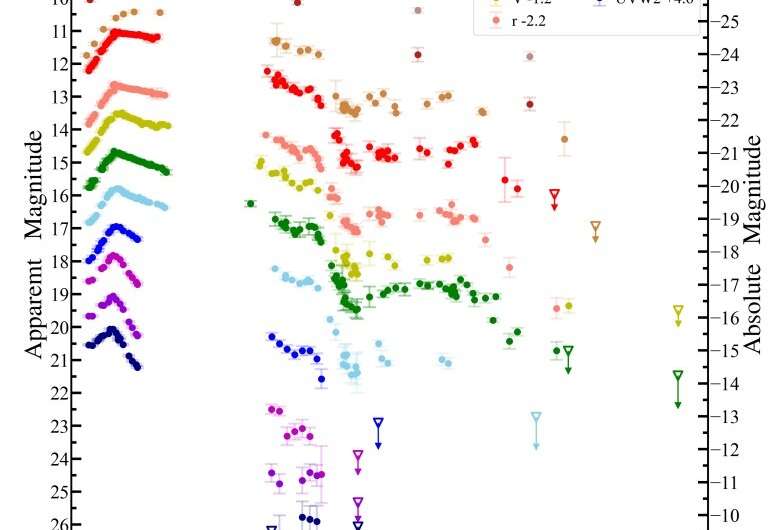March 15, 2023 report
This article has been reviewed according to Science X's editorial process and policies. Editors have highlighted the following attributes while ensuring the content's credibility:
fact-checked
preprint
trusted source
proofread
SN 2017egm is a helium-rich superluminous supernova, study finds

Using various ground-based and space observatories, an international team of astronomers has investigated a nearby supernova designated SN 2017egm. As a result, they found that the inspected explosion belongs to a rare group of helium-rich superluminous supernovae. The finding is reported in a paper published March 6 on the arXiv pre-print server.
Supernovae (SNe) are powerful and luminous stellar explosions. They are important for the scientific community as they offer essential clues into the evolution of stars and galaxies. In general, SNe are divided into two groups based on their atomic spectra: Type I and Type II. Type I SNe lack hydrogen in their spectra, while those of Type II showcase spectral lines of hydrogen.
Superluminous supernovae (SLSNe) are characterized by exceptionally bright, often long-lived light curves. Interaction of the SN ejecta with surrounding circumstellar material (CSM) is an efficient mechanism to convert kinetic energy of the ejecta into radiation and it is assumed that such a process may power SLSNe. As with normal SNe, SLSNe are also categorized into two classes based on their spectra around maximum light: hydrogen-poor (SLSNe-I) and hydrogen-rich events (SLSNe-II).
SN 2017egm (also known as Gaia17biu) is an SLSNe-I discovered by the Photometric Science Alerts Team of ESA's Gaia mission on May 23, 2017, at a redshift of 0.03. Its host galaxy, NGC 3191, is massive and has a near-solar metallicity, in contrast to the typical dwarf and metal-poor host galaxies for SLSNe-I. SN 2017egm was the closest hydrogen-poor superluminous supernova when discovered.
Recently, a team of astronomers led by Jiazheng Zhu of the University of Science and Technology of China in Hefei, China, performed photometric and spectroscopic SN 2017egm in order to get more insights into its properties.
"In this paper, we present the most complete photometric and spectroscopic analysis of SN 2017egm, taking our observational data and all public data together," the researchers wrote.
The study found that the long-term multiband light curves of SN 2017egm spanning about 300 days have a sharp peak, rapid decline, and multiple late-time bumps. Moreover, the spectra of this SLSN showcase strong helium lines.
Based on these findings, the astronomers categorized SN 2017egm into the subclass of slowly-evolving SLSNe-I according to the luminosity and color evolution near peak brightness. Due to the presence of the helium features, they further classified SN 2017egm as an helium-rich superluminous supernova (SLSN-Ib), which is a rare yet accumulating subpopulation of SLSNe-I.
The research also found that SN 2017egm had a significant infrared excess, at a level of 100 million solar luminosities, suggesting dust echoes from a pre-existing dust shell or emission from newly formed dust. The authors of the paper estimate that SN 2017egm had an ejecta mass of approximately 10.7 solar masses.
More information: Jiazheng Zhu et al, SN2017egm: A Helium-rich Superluminous Supernova with Multiple Bumps in the Light Curves, arXiv (2023). DOI: 10.48550/arxiv.2303.03424
Journal information: arXiv
© 2023 Science X Network




















